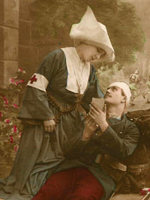George M. Murrell Home [OK]
When the Cherokees were forced to leave their homes in the East during the "Trail of Tears" in 1838—39, Murrell chose to move with his Cherokee wife's family to the new Nation in the West. In Park Hill, Indian Territory, he established a plantation and built a large frame home similar to those he remembered in Virginia. He called the Greek Revival-style house "Hunter's Home" because of his fondness for the fox hunt.
The home offers tours, workshops, living history demonstrations, and occasional educational and recreational events.
